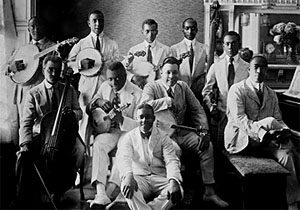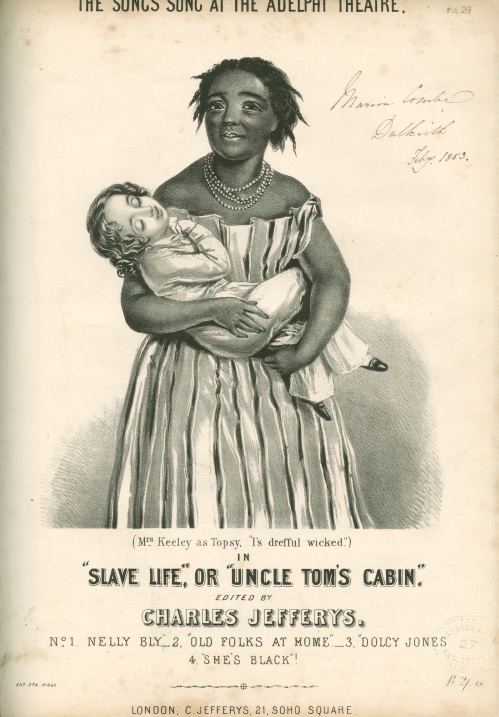
Location: Historic American Sheet Music Collection, Duke University, Durham, North Carolina
Title of Song: My Ole Home in Alabama ‘fo’ de War
Composer: Rutledge, John T.
Illustrator: Baker, J.E.
Publisher: G.D. Russell
Year & Place: 1875, Boston, Massachusetts
Collection/Call Number/Copies: Music# B-658
Historic American Sheet Music Item #: b0658
Basic Description
A bearded African American man grips a cane and stares into space with a look of consternation. Judging from the anchor to his right and the faint outlines of clipper ships, this is a wharf or dock. A worker pulling a barrel looks at the man with an inane expression. He wears light clothing with rolled-up shirtsleeves, while the old man wears a coat and scarf. It is not clear if the older man works at the dock or is just passing through. The wind whipping through his scarf and his heavier dress imply that he is cold or, given the dockworker’s dress, unsuited to the climate. The pouch tied to his waist seems out of context, like something a seventeenth-century European bard would have. In the top right of the frame is a smaller image of a man and woman in fancy clothing, stepping through a mass of flowers outside what seems to be a house. This is evidently the old man’s memory. The dark shadows of the wharf contrast effectively with the brightness of this vision; this remembered place is warm and filled with light while the wharf is cold and foggy. A dog sniffs the man’s feet. The title of the piece is artistically woven into the illustration itself.
Personal Description
The message of this lithograph is ambiguous– is this a former slave who is uncomfortable in the post-Civil War context? Does it reflect sympathy for everyone who had to leave their homes as a result of the Civil War? The artist renders the man almost with pathos and also without any of the characteristics common to racist caricature at the time. The man appears cold and overtaken with nostalgia for the past, a sentiment that is emphasized by the artist’s use of a high contrast. The space of the man’s memory is brightly lit while the dock is somewhat dark and shadowy. The darkness of the dock combined with the man’s serious expression, especially in contrast with the dockworker’s goofiness, create a sense of isolation and alienation. The posters behind the African American man’s body advertise boat trips to Alabama, which the title suggests is the man’s home. If the message of the image matches that of the title, one is left to wonder what stops this man from hopping one of these boats. Perhaps this is what he is about to do.
George Washington Williams, was a 19th century American historian most famous for his volumes, History of the Negro Race in America from 1619 to 1880; as Negroes, as Slaves, as Soldiers, and as Citizens (1882), and A History of the Negro Troops in the War of the Rebellion (1887).Williams was born in 1849 in Bedford Springs, Pennsylvania and lived there until 1864, when at the age of 14 and lacking virtually any education he left home to join the Union Army. Engaged by the soldier’s lifestyle, he followed this by fighting in Mexico in the overthrow of Maximilian.
After his military career and out of a deep desire for education Williams attended the Newton Theological Institution in Massachusetts. By the time he was 25 years old he had graduated, married, and become pastor of the Twelfth Baptist Church in Boston. During the next several years he wrote as a columnist for the Cincinnati Commercial, became a lawyer, founded a Boston newspaper called The Commoner (1875), and became the first black member of his state legislature.
Williams spent only one term in political office, partly because he saw little chance of reelection, and partly because he increasingly desired to commit the majority of his time to working as a historian. In his historical works Williams strove for objectivity and the truthful recording of history, but he also essentially wrote from a revisionist perspective. He researched avidly and wrote with the goal of rerecording American history to honestly and responsibly include the roles and experiences of African Americans.
His first text, The History of the Negro Race in America, received a plethora of literary reviews — largely favorable critiques. Of the negative reviews he faced, most critics noted that his writing style tended to be overblown and was tinted by his theological training. Nonetheless almost all reviewers noted the immense value of the work he had done. Public reaction was by and large a kind of amazement — both because of the extent of his work (the text was two volumes in total) and because he was an African American. In fact his light skin tone and dignified demeanor gained him more respect from white Americans than may have been expected at the time. A History of the Negro Troops received similar but generally better reviews.
In 1890 Williams studied conditions in the Belgian Congo at the commission of President Benjamin Harrison and on one occasion wrote a letter of complaint to the Belgian Crown about the treatment of the indigenous Africans. Although he had hoped to spark a movement in protest of the Belgian government’s role in its African colony, little came of his effort in the U.S. He then moved to England to work on a book which would focus on Africa. Unfortunately Williams fell ill shortly after arriving in England and died at the age of 41.









